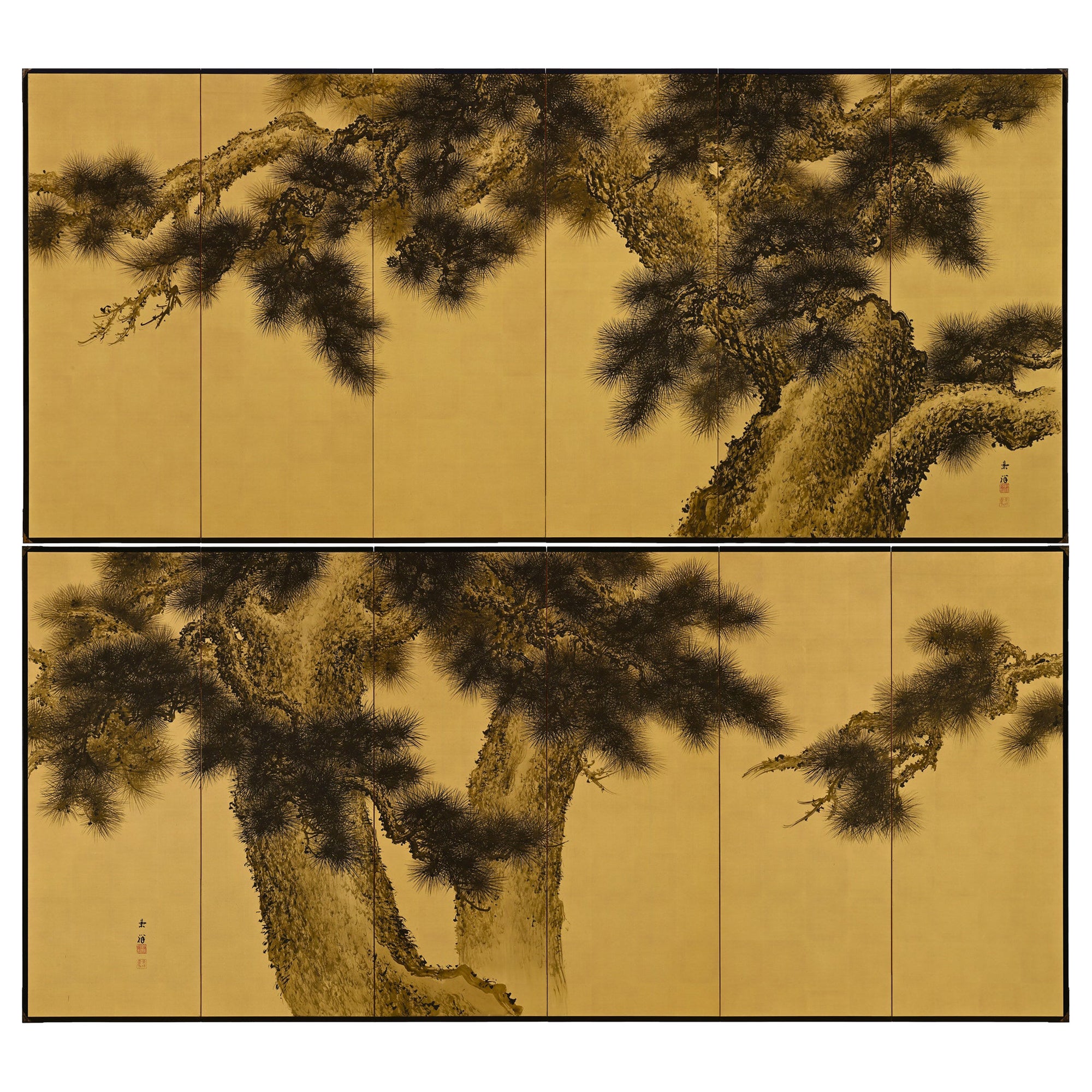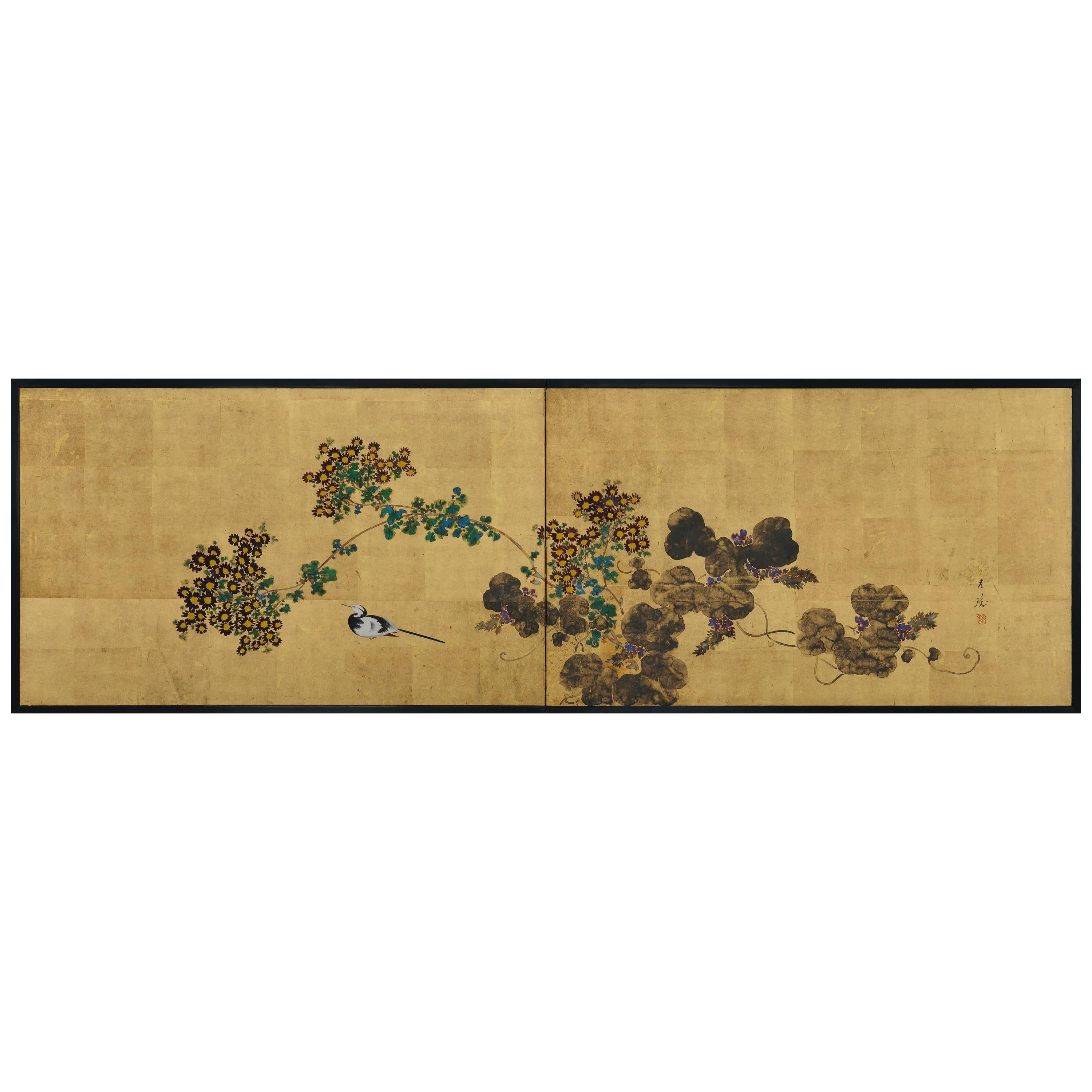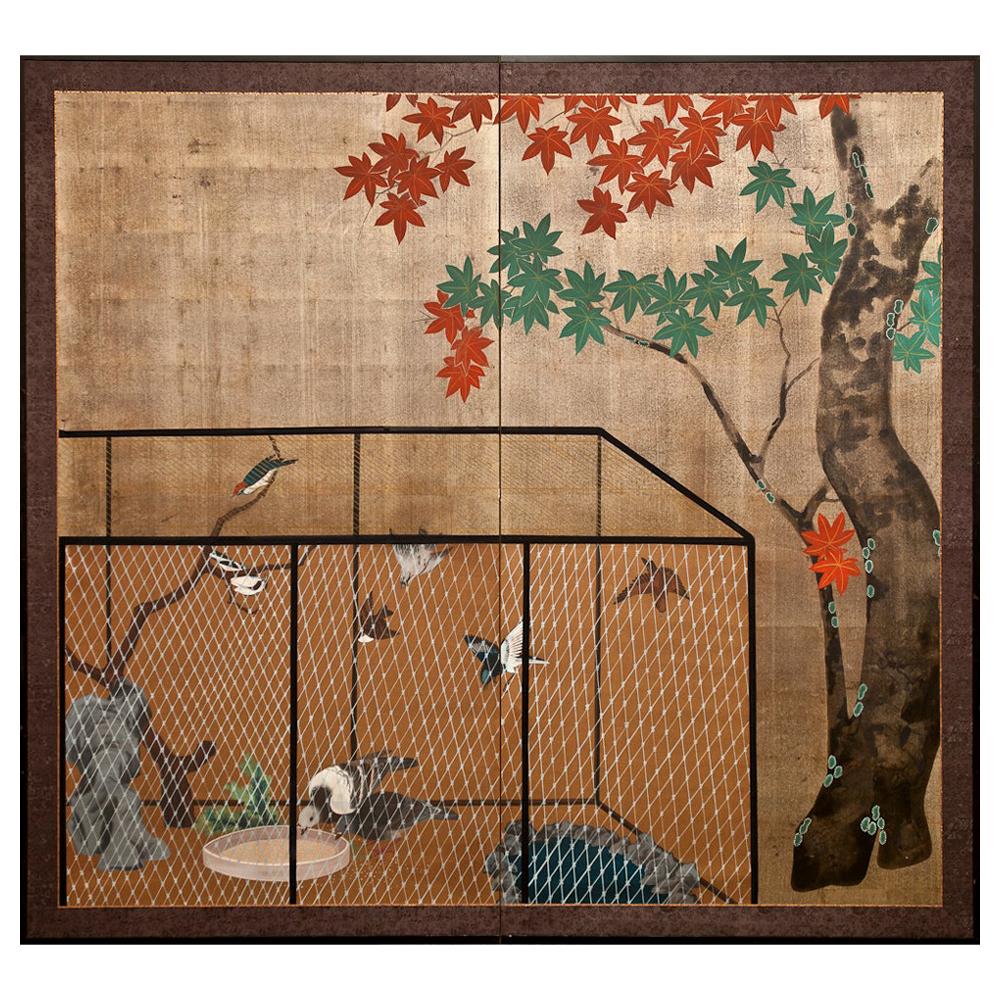Items Similar to Early 20th Century Pair of Japanese Folding Screens, Deer Under Maple Trees
Want more images or videos?
Request additional images or videos from the seller
1 of 9
Early 20th Century Pair of Japanese Folding Screens, Deer Under Maple Trees
About the Item
Deer under maples
Late Taisho period, circa 1925-1930
Pair of two-panel screens. Ink and pigment on silk.
Signature: Goho
Seal: Goho
A pair of two-fold Japanese silk screens from the later Taisho period depicting deer under maple trees. In this shimmering evocation of spring, the doe is pictured with her fawn, their bodies entwined. The new leaves of the maple trees are painted with mineral pigments in lush hues of green. The delicate and meticulous brushwork of the deer contrasts dramatically with the heavily outlined foliage and the broad application of saturated colors. At the top right of the scene a faded vermillion railing peeks through the leaves. This visual clue likely alludes to the parklands of Nara where deer freely wander. Shinto religion and local beliefs hold that a deity named Takemikazuchi arrived in the old capital of Nara on a deer to act as the city's protector, and as a result, the deer of Nara are considered sacred, messengers of the gods.
In this pair of screens the artist is not overly concerned with creating the illusion of three-dimensional space, but rather seems to be interested in stylizing the shapes and forms of the depicted subjects. The work brings to mind the vividness and excess of the Rinpa school, and represents the liberalism of the Taisho period as it is being drawn toward the more geometrically organized, rigid compositions of the Showa period.
Both the signature and seal read Goho. There is a possibility that it is the work of an artist named Tanaka Goho from Wakayama prefecture who died in 1929. Unfortunately we do not have information to make a judgement.
The screens display perfectly and have been conserved and fully re-mounted in Kyoto utilizing traditional techniques and craftsmen.
- Dimensions:Height: 67 in (170.18 cm)Width: 74 in (187.96 cm)Depth: 0.75 in (1.91 cm)
- Sold As:Set of 2
- Style:Taisho (Of the Period)
- Materials and Techniques:
- Place of Origin:
- Period:
- Date of Manufacture:circa 1925-1930
- Condition:Refinished. The screens display perfectly and have been conserved and fully re-mounted in Kyoto utilizing traditional techniques and craftsmen.
- Seller Location:Kyoto, JP
- Reference Number:1stDibs: LU2472320999382
About the Seller
5.0
Recognized Seller
These prestigious sellers are industry leaders and represent the highest echelon for item quality and design.
Gold Seller
These expertly vetted sellers are highly rated and consistently exceed customer expectations.
Established in 2001
1stDibs seller since 2016
60 sales on 1stDibs
Typical response time: 6 hours
- ShippingRetrieving quote...Ships From: Kyoto, Japan
- Return PolicyA return for this item may be initiated within 10 days of delivery.
More From This SellerView All
- Early 20th Century Japanese Screen Pair, Fig Trees by Hiroe Kashu 'B.1890'Located in Kyoto, JPFig Trees Hiroe Kashu (b.1890) Taisho era, circa 1920 Pair of six-fold Japanese screens Ink, malachite, gold and silver on paper Dimensions: Each Screen measures H...Category
Early 20th Century Asian Taisho Paintings and Screens
MaterialsGold, Silver
- Early 20th Century Japanese Screen Pair - Ink Pine Trees on GoldLocated in Kyoto, JPImao Keisho (1902-1993) Pine Trees Early 20th Century, Circa 1930 Pair of six-panel Japanese screens. Ink on silk and gold leaf. Dimensions: Each screen H. 67.5” x 148” (172 cm x 376 cm) A pair of monumental six-panel Japanese pine screens by the renowned Nihonga artist Imao Keisho. Here Keisho entirely removed the background and brought the pine trees to the surface of the painting. This simplification of the elements makes the scene exceptionally direct and compelling and injects a very modern...Category
Early 20th Century Japanese Showa Paintings and Screens
MaterialsGold Leaf
- Japanese Screen, Early 20th Century Wagtail & Chrysanthemum by Ishizaki KoyoLocated in Kyoto, JPIshizaki Koyo (1884-1947) Wagtail & Chrysanthemum Early 20th century Folding screen in two-panels. Ink, pigments and gofun on gold leaf. Sign: Koyo Seal: Koyo This ...Category
Early 20th Century Japanese Taisho Paintings and Screens
MaterialsGold Leaf
- Early 20th Century Japanese Cherry Blossom Screen by Kano SanrakukiLocated in Kyoto, JPCherry Blossoms Kano Sanrakuki (1898-1981) Showa period, circa 1930 2-panel Japanese Screen Color, gofun and gold leaf on paper Against a backdrop of gold-leafed ground, the lichen covered trunk and branches of the life-sized cherry blossom tree reach out and beyond the confines of the pictorial surface. The overall composition has a feeling of flatness which draws emphasis to the surface and the three-dimensionality of the cherry blossoms. Painstakingly built-up layers of thickly applied shell-white gofun detail the voluminous blossoms and cover large areas of this tour-de-force of Japanese Nihonga painting. By simplifying the background, minimizing the number of colors and depicting the blossoms with such heavy relief, the artist has emphasized the stunning presence of the cherry tree. The type of tree depicted is the Yae-Zakura; a double-layered type of cherry blossom famed for its beauty and strength. When we think of Japanese cherry blossoms, the first thing that comes to mind is Somei Yoshino variety, which has a single flower with five almost white petals. This type is fragile and easily blown away by strong wind or rain. Most of the double-flowered cherry blossoms begin to bloom when the Somei-Yoshino falls, and the flowering period lasts longer than that of the Somei-Yoshino. Kano Sanrakuki originally studied painting at the Kyoto City Arts and Crafts School under the tutelage of Yamamoto Shunkyo...Category
Early 20th Century Japanese Showa Paintings and Screens
MaterialsGold Leaf
- Early 20th Century Japanese Framed Painting, White Peacocks on Silk and GoldLocated in Kyoto, JPKasahara Seiken White peacocks, circa 1916 Framed painting. Ink, color and gofun on silk. A Taisho period Japanese nihonga painting depicting a pair of white peacocks re...Category
Early 20th Century Japanese Taisho Paintings and Screens
MaterialsGold Leaf
- 17th Century Japanese Screen Pair, CranesLocated in Kyoto, JPCranes Anonymous, Kano School. Edo period, second half of the 17th century. Pair of six-panel screens. Ink, pigment gofun and gold l...Category
Antique 1670s Japanese Edo Paintings and Screens
MaterialsGold Leaf
You May Also Like
- Japanese Two Panel Screen Aviary Shaded by A Maple TreeLocated in Hudson, NYJapanese Two Panel Screen: Aviary Shaded By A Maple Tree, Showa period (1926 - 1989) painting of an outdoor bird enclosure under a maple tree. Painted in ...Category
Mid-20th Century Japanese Showa Paintings and Screens
MaterialsSilk, Wood, Paper
- Pair of Mid-20th Century chinoiserie Screens, Hand Painted,Located in Milano, ITPair of Mid-20th Century chinoiserie screens, hand painted, similar but different figures of Chinese notables.Category
Mid-20th Century French Chinoiserie Paintings and Screens
MaterialsFruitwood
- 20th Century Showa Period Beautiful Spring Garden Folding Screen Two PanelsLocated in Brescia, ITJapanese screen with two doors painted with mineral pigments on rice paper. Early Showa period.Category
Late 20th Century Japanese Showa Paintings and Screens
MaterialsPaper
- Pair of Burmese Early 20th Century Giltwood Framed PaintingsLocated in Lambertville, NJA pair of vibrantly colored Burmese water color paintings of Deities. The early 20th century paintings in mid 20th century professionally framed giltwood frames.Category
Early 20th Century Asian Paintings
MaterialsGlass, Giltwood, Paper
- Japanese Two-Panel Screen, Wading DeerLocated in Hudson, NYIn Japan, it is a Shinto belief that the deer is a treasured and sacred animal. This admirable scene captures this gentle creature in its natural habitat with beautiful detail in bot...Category
Early 20th Century Japanese Paintings and Screens
MaterialsSilk, Lacquer
- Japanese Four Panel Screen: Scotties Under RosesLocated in Hudson, NYModern painting in mineral pigments on mulberry paper with a silk brocade border.Category
20th Century Japanese Paintings and Screens
MaterialsBrocade, Silk, Paper
Recently Viewed
View AllMore Ways To Browse
20th Century Screen
Folded Paper Furniture
Silk Trees
Older Maple Furniture
Screen With Trees
Deer Wood
20th Century Japanese Silk
Japanese Silk Screens
Brown Folding Screen
Painted Folding Screen
Folding Picture
Wood Folding Screen
20th Century Folding Screen
Taisho Period
Hand Painted Silk Screen
Painting Of Woods And Trees
Painting Folding Screen
Paper Folding Screen





